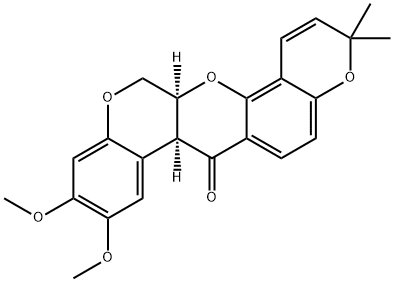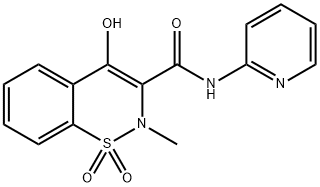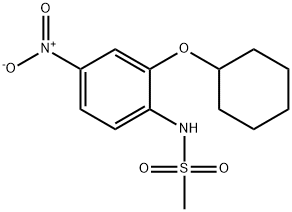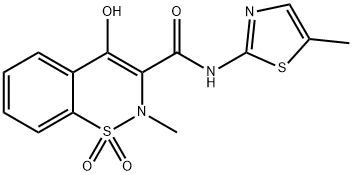DEGUELIN
Synonym(s):(7aS,13aS)-13,13a-Dihydro-9,10-dimethoxy-3,3-dimethyl-3H-bis[1]benzopyrano[3,4-b:6′,5′-e]pyran-7(7aH)-one
- CAS NO.:522-17-8
- Empirical Formula: C23H22O6
- Molecular Weight: 394.42
- MDL number: MFCD01740600
- EINECS: 200-258-5
- SAFETY DATA SHEET (SDS)
- Update Date: 2025-01-27 09:38:02

What is DEGUELIN?
Description
Rotenoids, deriving from the flavonoid family of compounds, act as chemopreventive agents that inhibit NADH:ubiquinone oxidoreductase activity and suppress phorbol ester-
The Uses of DEGUELIN
Deguelin exhibits potent apoptotic and antiangiogenic activities in a variety of transformed cells and cancer cells. Deguelin also exhibits potent tumor suppressive effects in xenograft tumor models for many human cancers.
The Uses of DEGUELIN
antineoplastic, antiviral, insecticide, ornithine decarboxylate inhibitor
The Uses of DEGUELIN
(?)-Deguelin has been used as:
- a nicotinamide adenine dinucleotide hydrogen (NADH) dehydrogenase (Complex I) inhibitor to study its effects on mitochondrial respiratory inhibition in human hepatocarcinoma cells (HepG2) and human renal proximal tubule epithelial cells (RPTECs)
- an antiviral compound to study inhibitory effects on human cytomegalovirus (HCMV)-infected human foreskin fibroblast (HFF) cells
- an analytical standard in high-performance liquid chromatography (HPLC)
What are the applications of Application
Deguelin is an inhibitor of Cox-2
Definition
ChEBI: Deguelin is a rotenone that is 13,13a-dihydro-3H-chromeno[3,4-b]pyrano[2,3-h]chromen-7(7aH)-one substituted by methoxy groups at positions 9 and 10, and by two methyl groups at position 3 (the 7aS,13aS-stereoisomer). It exists in abundant quantities in the bark, roots, and leaves of the Leguminosae family of plants and reported to exert anti-tumour effects in various cancers. It has a role as an apoptosis inducer, an antineoplastic agent, a plant metabolite, an angiogenesis inhibitor, an antiviral agent, a mitochondrial NADH:ubiquinone reductase inhibitor, an anti-inflammatory agent and an EC 2.7.11.1 (non-specific serine/threonine protein kinase) inhibitor. It is a member of rotenones, an aromatic ether, an organic heteropentacyclic compound and a diether.
Biological Activity
Anticancer and antiviral agent; chemopreventive and pro-apoptotic. Inhibits phorbol ester-induced ornithine decarboxylase and NADH:ubiquinone oxidoreductase activities (IC 50 values are 11 and 6.9 nM respectively). Inhibits PI 3-kinase and reduces pAkt levels in pre-malignant and malignant human bronchial epithelial cells. Active in vivo .
Biochem/physiol Actions
Deguelin is a natural rotenoid compound present abundantly in barks, leaves, seeds, and roots of the plants belonging to the Leguminosae family. Deguelin has been studied as a therapeutic agent against the skin, lung cancer, and mammary tumorigenesis.
References
1) Chun et al. (2003), Effects of deguelin on the phosphatidylinositol 3- kinase/Akt pathway and apoptosis in premalignant human bronchial epithelial cells; J. Natl. Cancer Inst., 95 291 2) Kang et al. (2012), Deguelin, an AKT Inhibitor, Down-Regulates NFκB Signaling and Induces Apoptosis in Colon Cancer Cells and Inhibits Tumor Growth in Mice; Dig. Dis. Sci.,?57 2873 3) Lee et al. (2004), Molecular mechanisms of deguelin-induced apoptosis in transformed human bronchial epithelial cells; Biochem. Pharmacol., 68 1119 4) Ito et al. (2004), Cancer chemopreventive activity of rotenoids from Derris trifoliata; Planta Med., 70 8
Properties of DEGUELIN
| Melting point: | 85-87 °C(lit.) |
| Boiling point: | 560.1±50.0 °C(Predicted) |
| alpha | D27 -97.2° (c = 0.2 in benzene) |
| Density | 1?+-.0.06 g/cm3(Predicted) |
| storage temp. | -20°C |
| solubility | DMSO: >10 mg/mL |
| form | solid |
| color | white to yellow |
| optical activity | [α]/D -70 to -80°, c = 0.2 in methanol |
| Stability: | Stable for 2 years from date of purchase as supplied. Solutions in DMSO or ethanol may be stored at -20° for up to 3 months. |
Safety information for DEGUELIN
Computed Descriptors for DEGUELIN
New Products
1-Amino-1-cyclohexanecarboxylic acid 6-Bromo-3-iodo-1-methyl-1H-indazole 3-(2,4-Dimethoxybenzyl)dihydropyrimidine-2,4(1H,3H)-dione S-Methylisothiosemicarbazide hydroiodide ELECTROLYTIC IRON POWDER 1-Aminocyclobutanecarboxylic acid 1-(2-Ethoxyethyl)-2-(piperidin-4-yl)-1H-benzo[d]imidazole hydrochloride tert-butyl 4-(1H-benzo[d]iMidazol-2-yl)piperidine-1-carboxylate Decanonitrile N,N'-diallyl-1,3-diaminopropanedihydrochloride N-(3-Nitrophenyl)cyclopropanecarboxamide (2-amino-2-phenylethyl)(methyl)amine Methyl-2-acetamidobenzoate methyl 6-chloro-2-(chloromethyl)nicotinate 2-methoxy-4-methyl-5-nitro pyridine 2-iodo-5-bromo pyridine 2-amino-4-methyl-5-nitro pyridine 4-cyano benzaldehyde 2-hydroxy-5-bromo pyridine 5-Fluoro-2-Oxindole 3,5-Dichloro-2,6-Dimethyl-1h-Pyridin-4-One (9H-fluoren-9-yl)methyl carbonochloridate 2-methyl-5-nitroaniline (S)-1-(tert-butoxycarbonyl)-4-oxopyrrolidine-2-carboxylic acidRelated products of tetrahydrofuran








You may like
-
 (−)-Deguelin CAS 522-17-8View Details
(−)-Deguelin CAS 522-17-8View Details
522-17-8 -
 4 Chloro 6,7 Dimethoxy Quinoline (Cabozantinib intermediate)View Details
4 Chloro 6,7 Dimethoxy Quinoline (Cabozantinib intermediate)View Details
35654-56-9 -
 3,4 Difluoro benzaldehydeView Details
3,4 Difluoro benzaldehydeView Details
34036-07-2 -
 10,10 Dimethyl AnthroneView Details
10,10 Dimethyl AnthroneView Details
5447-86-9 -
 Methyl 3 cyclohexene 1 carboxylateView Details
Methyl 3 cyclohexene 1 carboxylateView Details
6493-77-2 -
 Tri isopropyl borate (TIPB)View Details
Tri isopropyl borate (TIPB)View Details
5419-55-6 -
 Indazole 3 carboxylic acidView Details
Indazole 3 carboxylic acidView Details
4498-67-3 -
 2 Hydroxy 4 methoxy benzoic acidView Details
2 Hydroxy 4 methoxy benzoic acidView Details
2237-36-7